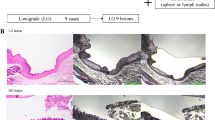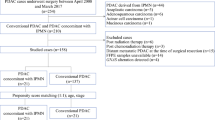Abstract
Background
Solid pseudopapillary neoplasm (SPN) is a distinct pancreatic neoplasm and has characteristic, aberrant nuclear expression of β-catenin in most cases. However, alterations in components of the Wnt pathway, other than the β-catenin (CTNNB1) gene mutation, have not been identified. In this study, we investigated the status of Axin-1, the spectrum of mutations in the CTNNB1 gene, and the clinicopathological features of SPNs.
Materials and Methods
We collected 27 SPNs from 25 patients. A tissue microarray was constructed to perform immunohistochemistry for β-catenin, E-cadherin, and Axin-1. The CTNNB1 and AXIN1 gene mutations were analyzed by DNA sequencing. Finally, the clinicopathological features of SPNs were analyzed for association with the CTNNB1 mutations and the Axin-1 alterations.
Results
All 27 SPNs expressed nuclear immunoreactivity of β-catenin and exhibited a lack of membranous decoration of E-cadherin. All SPNs harbored CTNNB1 gene mutations. No alterations were present in the AXIN1 gene, and the immunohistochemical analysis revealed weak or absent reactivity of Axin-1 in the cytosol. All cases with a codon-37 CTNNB1 mutation had weak Axin-1 immunoreactivity in the cytoplasm (P = 0.018). No other significant correlation was found between clinicopathological parameters, CTNNB1 mutations, and Axin-1 alterations.
Conclusions
Nuclear β-catenin immunoexpression is characteristic for SPNs and corresponds to the CTNNB1 mutation. The Wnt pathway is involved in the tumorigenesis of SPNs, primarily through the alteration of β-catenin. Despite the absence of any identifiable genetic mutation, a low level of Axin-1 in the cytoplasm might contribute to the aberrant distribution of β-catenin in SPNs.



Similar content being viewed by others
References
Papavramidis T, Papavramidis S. Solid pseudopapillary tumors of the pancreas: review of 718 patients reported in English literature. J Am Coll Surg. 2005;200:965–72.
Kloppel G, Hruban RH, Klimstra DS, et al. Solid-pseudopapillary neoplasm of the pancreas. In: Bosman FT, Carneiro F, Hruban RH, Theise ND, editors. WHO classification of tumours of the digestive system. Lyon: IARC; 2010. p. 327–30.
Tang LH, Aydin H, Brennan MF, Klimstra DS. Clinically aggressive solid pseudopapillary tumors of the pancreas: a report of two cases with components of undifferentiated carcinoma and a comparative clinicopathologic analysis of 34 conventional cases. Am J Surg Pathol. 2005;29:512–19.
Serra S, Chetty R. Revision 2: an immunohistochemical approach and evaluation of solid pseudopapillary tumour of the pancreas. J Clin Pathol. 2008;61:1153–9.
Tanaka Y, Kato K, Notohara K, Hojo H, Ijiri R, Miyake T, et al. Frequent β-catenin mutation and cytoplasmic/nuclear accumulation in pancreatic solid-pseudopapillary neoplasm. Cancer Res. 2001;61:8401–4.
Abraham SC, Klimstra DS, Wilentz RE, Yeo CJ, Conlon K, Brennan M, et al. Solid-pseudopapillary tumors of the pancreas are genetically distinct from pancreatic ductal adenocarcinomas and almost always harbor β-catenin mutations. Am J Pathol. 2002;160:1361–69.
Tang WW, Stelter AA, French S, Shen S, Qiu S, Venegas R, et al. Loss of cell-adhesion molecule complexes in solid pseudopapillary tumor of pancreas. Mod Pathol. 2007;20:509–13.
El-bahrawy MA, Rowan A, Horncastle D, Tomlinson I, Theis BA, Russell RC, et al. E-cadherin/catenin complex status in solid pseudopapillary tumor of the pancreas. Am J Surg Pathol. 2008;32:1–7.
Kim MJ, Jang SJ, Yu E. Loss of E-cadherin and cytoplasmic-nuclear expression of β-catenin are the most useful immunoprofiles in the diagnosis of solid-pseudopapillary neoplasm of the pancreas. Hum Pathol. 2008;39:251–8.
Clevers H. Wnt/β-catenin signaling in development and disease. Cell. 2006;127:469–80.
Liu C, Li Y, Semenov M, Han C, Baeg GH, Tan Y, et al. Control of beta-catenin phosphorylation/degradation by a dual-kinase mechanism. Cell. 2002;108:837–47.
Luo W, Lin SC. Axin: a master scaffold for multiple signaling pathways. Neurosignals. 2004;13:99–113.
Aberle H, Bauer A, Stappert J, Kispert A, Kemler R. Beta-catenin is a target for the ubiquitin–proteasome pathway. EMBO J. 1997;16:3797–804.
Eastman Q, Grosschedl R. Regulation of LEF-1/TCF transcription factors by Wnt and other signals. Curr Opin Cell Biol. 1999;11:233–40.
Korinek V, Barker N, Morin PJ, van Wichen D, de Weger R, Kinzler KW, et al. Constitutive transcriptional activation by a β-catenin -Tcf complex in APC−/− colon carcinoma. Science. 1997;275:1784–97.
Zeng L, Fagotto F, Zhang T, Hsu W, Vasicek TJ, Perry WL 3rd, et al. The mouse Fused locus encodes Axin, an inhibitor of the Wnt signaling pathway that regulates embryonic axis formation. Cell. 1997;90:181–92.
Satoh S, Daigo Y, Furukawa Y, Kato T, Miwa N, Nishiwaki T, et al. AXIN1 mutations in hepatocellular carcinomas, and growth suppression in cancer cells by virus-mediated transfer of AXIN1. Nat Genet. 2000;24:245–50.
Dahmen RP, Koch A, Denkhasu D, Tonn JC, Sorensen N, Berthold F, et al. Deletions of AXIN1, a component of the WNT/wingless pathway, in sporadic medulloblastomas. Cancer Res. 2001;61:7039–43.
Webster MT, Rozycka M, Sara E, Davis E, Smalley M, Young N, et al. Sequence variants of the axin gene in breast, colon, and other cancers: an analysis of mutations that interfere with GSK3 binding. Genes Chromosom Cancer. 2000;28:443–53.
Wu R, Zhai Y, Fearon ER, Cho KR. Diverse mechanisms of beta-catenin deregulation in ovarian endometrioid adenocarcinomas. Cancer Res. 2001;61:8247–55.
Nakajima M, Fukuchi M, Miyazaki T, Masuda N, Kato H, Kuwano H. Reduced expression of Axin correlates with tumour progression of oesophageal squamous cell carcinoma. Br J Cancer. 2003;88:1734–9.
Kim YD, Park CH, Kim HS, Choi SK, Rew JS, Kim DY, et al. Genetic alterations of Wnt signaling pathway-associated genes in hepatocellular carcinoma. J Gastroenterol Hepatol. 2008;23:110–8.
Ren ZP, Sällström J, Sundström C, Nistér M, Olsson Y. Recovering DNA and optimizing PCR conditions from microdissected formalin-fixed and paraffin-embedded materials. Pathobiology. 2000;68:215–7.
Kim SM, Sun CD, Park KC, Kim HG, Lee WJ, Choi SH. Accumulation of β-catenin protein, mutations in exon-3 of the β-catenin gene and a loss of heterozygosity of 5q22 in solid pseudopapillary tumor of the pancreas. J Surg Oncol. 2006;94:418–25.
Takahashi Y, Hiraoka N, Onozato K, Shibata T, Kosuge T, Nimura Y, et al. Solid-pseudopapillary neoplasms of the pancreas in men and women: do they differ? Virchows Arch. 2006;448:561–9.
Liu BA, Li ZM, Su ZS, She XL. Pathological differential diagnosis of solid-pseudopapillary neoplasm and endocrine tumors of the pancreas. World J Gastroenterol. 2010;16:1025–30.
Wu G, Xu G, Schulman BA, Jeffrey PD, Harper JW, Pavletich NP. Structure of a beta-TrCP-1-Skp1-beta-catenin complex: destruction motif binding and lysine specificity of the SCF (beta-TrCP1) ubiquitin ligase. Mol Cell. 2003;11:1445–56.
Taniguchi K, Roberts LR, Aderca IN, Dong X, Qian C, Murphy LM, et al. Mutational spectrum of β-catenin, AXIN1, and AXIN2 in hepatocellular carcinomas and hepatoblastomas. Oncogene. 2002;21:4863–71.
Kishida M, Koyama S, Kishida S, Matsubara K, Nakashima S, Higano K, et al. Axin prevents Wnt-3a-induced accumulation of β-catenin. Oncogene. 1999;18:979–85.
Yamamoto H, Kishida S, Kishida M, Ikeda S, Takada S, Kikuchi A. Phosphorylation of axin, a Wnt signal negative regulator, by glycogen synthase kinase-3beta regulates its stability. J Biol Chem. 1999;274:10681–4.
Lee E, Salic A, Kruger R, Heinrich R, Kirschner MW. The roles of APC and Axin derived from experimental and theoretical analysis of the Wnt pathway. PLoS Biol. 2003;1:E10.
Neo SY, Zhang Y, Yaw LP, Li P, Lin SC. Axin-induced apoptosis depends on the extent of its JNK activation and its ability to down-regulate β-catenin levels. Biochem Biophys Res Commun. 2000;272:144–50.
Hsu W, Shakya R, Costantini F. Impaired mammary gland and lymphoid development cased by inducible expression of Axin in transgenic mice. J Cell Biol. 2001;155:1055–64.
Provost E, Yamamoto Y, Lizardi I, Stern J, D’Aquila TG, Gaynor RB, et al. Functional correlates of mutations in β-catenin exon 3 phosphorylation sites. J Biol Chem. 2003;278:31781–89.
Provost E, McCabe A, Stern J, Lizardi I, D’Aqiula TG, Rimm DL. Functional correlates of mutation of the Asp32 and Gly34 residues of beta-catenin. Oncogene. 2005;24:2667–76.
Acknowledgment
The work was supported by the grant DOH99-TD-C-111-006 from the Department of Health, Republic of China, and the grant CMRPG360923 and CMRPG340313 from the Chang Gung Memorial Hospital.
Disclosure
There is no disclosure of any commercial interest and the source of any financial or material support.
Author information
Authors and Affiliations
Corresponding author
Rights and permissions
About this article
Cite this article
Huang, SC., Ng, KF., Yeh, TS. et al. Clinicopathological Analysis of β-catenin and Axin-1 in Solid Pseudopapillary Neoplasms of the Pancreas. Ann Surg Oncol 19 (Suppl 3), 438–446 (2012). https://doi.org/10.1245/s10434-011-1930-x
Received:
Published:
Issue Date:
DOI: https://doi.org/10.1245/s10434-011-1930-x




